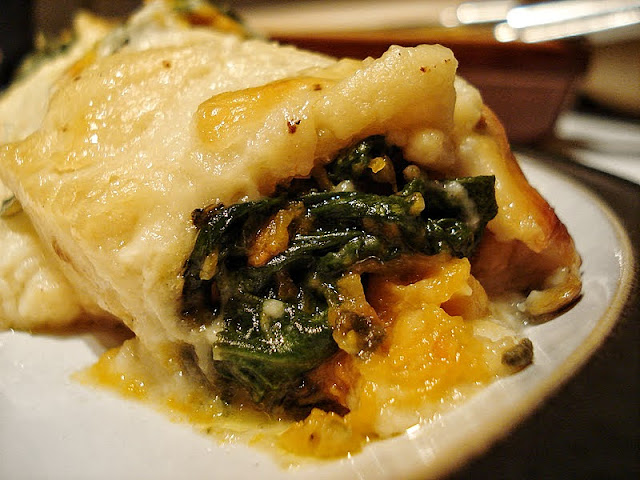Since pasta is not permitted on the Specific Carbohydrate Diet, making our favourite Italian dishes has been impossible. I experienced a brainwave while I was browsing the supermarket aisles that leeks might work instead of cannelloni.
Leeks are nature's answer to cannelloni tubes. They contain significant amounts of the flavonoid kaempferol which may possibly reduce the risk of developing cancer. They're also a good source Vitamin A, Vitamin B6 and Vitamin C as well as an excellent provider of bone-building vitamin K and manganese.
Butternut squash is a superb source of Vitamin A and it's one vegetable that we could not possibly live without. Here are a few things I've learned about choosing a good butternut squash :
- Pick a squash that is heavy for its size. this indicates a high moisture content.
- Bigger squash tend to have a more highly developed flavour
- The rind should be firm and unbroken
- The colour should be matte, if it is shiny it is a sign that it wasn't ripe when it was picked
- store in a cool, dry, well-ventilated place
Butternut Squash and Spinach Cannelloni GF SCD
4 large leeks
1 large butternut squash (about 1.5kg)
2 large handfuls spinach (about 80-100g)
10-12 sage leaves
sea salt and freshly ground black pepper
nutmeg
pumpkin seeds
extra virgin olive oil
Cheese Sauce
1 large cauliflower
2 medium onions (optional)
100g cheddar cheese
sea salt and freshly ground black pepper
OR Vegan Option
Tomato Sauce GF SCD
Leeks are renowned for holding the dirt inside their layers. However, the leeks for sale these days tend to be very clean. Sometimes there is a little dirt at the green end but rarely is there any at the white. Choose leeks no more than 4 cms in diameter or they could be tough! Prepare the leeks by slicing about 10-12 cms (4 or 5 inches) from the root end to form the tubes. Chop off the root base and discard any tough outer leaves. Give them a quick wash.
Place the leeks into a pan of boiling water and simmer for about 10 to 15 minutes making sure that the leaves don't split. Drain the water (you could use this for stock) and stand the leeks in the pan to cool. you will see that the inner layers have started to separate from the outer ones.
Meanwhile prepare the butternut squash. Set the oven to 200°C, slice the squash in two lengthways, spoon out the seeds, cut the squash into manageable pieces, peel the skin using a sharp knife or peeler then chop into small cubes.
Tip into a bowl and pour on two to three tablespoons of extra virgin olive oil. Season with sea salt and freshly ground black pepper.
Give the squash a good stir and tip into a roasting tin. Roast in the oven for about 30 to 40 minutes until tender.
Tip the roasted butternut squash into a large mixing bowl. Wash the sage leaves and chop.
Add the sage to the butternut squash and season well with sea salt and freshly ground black pepper. Add two large handfuls of washed young spinach leaves and mix well.
Place the leeks on to a board and gently push out the inside layers, leaving two or three outer layers intact.
Using a small spoon, gently stuff the tubes with the filling.
Brush a small roasting dish with extra virgin olive oil and lay the leeks on the base. Brush the leeks with some more oil and roast in the oven for 20 to 30 minutes until the outer layers are tender. Meanwhile make the cheese sauce. Follow the link for the recipe using onions or wash the cauliflower and cut into florets. Place in a pan of boiling water, bring to the boil and simmer for 20 minutes. Add the cheese, salt and pepper and blend well. If you prefer a dairy free version follow the directions for tomato sauce.
Take the leeks out of the oven and pour the sauce (cheese or tomato) over the top. Sprinkle on some pumpkins seeds. Grate a little nutmeg over the top.
Return to the oven for another 30 to 40 minutes until the cheese is golden and the leeks are cooked through.












